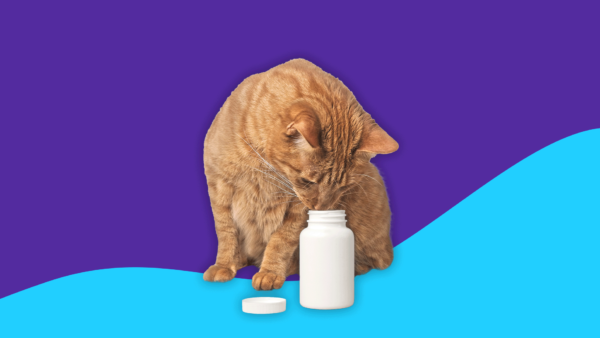Key takeaways
In dogs, furosemide treats heart failure, pulmonary edema, fluid retention, kidney failure, and electrolyte imbalances.
The standard furosemide dose for dogs varies by condition but can range from 1–4 mg/kg when given orally and 2–8 mg/kg when injected.
The most common side effects of furosemide in dogs are increased urination and thirst.
Do not give furosemide to dogs if the dog is not peeing or is allergic to the drug.
Discontinue furosemide and call a veterinarian if urine volume decreases severely or stops altogether.
Furosemide, known by the brands Lasix, Salis, and Disal, is commonly given to dogs to treat heart failure, kidney failure, fluid buildup in the lungs, and electrolyte abnormalities. As a diuretic, it increases the body’s elimination of water through the urine. It’s the most commonly used diuretic in veterinary medicine. Loop diuretics like furosemide work by increasing the excretion of electrolytes like sodium, chloride, and potassium, which then causes more water to pass into the urine. Because of this, furosemide and its cousins are very powerful and fast-acting. Additionally, loop diuretics can also be prescribed in high doses, so they’re often the first choice in a crisis.
RELATED: Save up to 80% on furosemide
What is furosemide used for in dogs?
Furosemide is a diuretic used to decrease water volume in dogs with heart failure, fluid buildup in the lungs (pulmonary edema), fluid accumulation (edema) due to other causes, kidney failure, and high electrolyte levels in the blood.
Congestive heart failure
Heart failure occurs when the heart doesn’t pump out enough blood to the rest of the body. One consequence is the build-up of fluids in certain places like the lungs, the chest, the abdomen (ascites), and other body parts. Furosemide increases the dog’s elimination of water through the urine, helping to drain excess fluid from places it doesn’t belong.
Pulmonary edema
Pulmonary edema is fluid buildup in the lungs, making breathing more difficult. While it has many causes, furosemide is the drug of choice for eliminating this excess fluid.
Edema
Furosemide can treat fluid buildup elsewhere in the body, but other diuretics are usually the drugs of choice in most cases. However, furosemide is a first choice when fluid buildup is due to a specific type of kidney disease involving one part of the kidney’s filtration mechanism. In those cases, furosemide can increase urine production to compensate for the kidney’s deficiency in urine production.
Kidney failure
Kidney failure describes any condition in which the kidneys are not eliminating enough water, electrolytes, and wastes to keep the body healthy. It has a variety of causes, but diuretics do not treat or cure those causes. Instead, loop diuretics like furosemide increase urine output if kidney failure significantly decreases urine volume.
Excess serum electrolytes
Furosemide and other loop diuretics not only increase the body’s elimination of water, but they also increase the body’s elimination of electrolytes such as sodium, chloride, calcium, potassium, and magnesium. Like humans, dogs can have too much of one of these electrolytes in their blood. If any electrolyte gets too high in the body, the condition can evolve into a severe and even life-threatening problem. Veterinarians use furosemide as a first-line treatment for dogs with high calcium levels (hypercalcemia) or high potassium levels (hyperkalemia) to quickly bring those levels back to normal.
Is furosemide safe for dogs?
The Food and Drug Administration (FDA) has approved furosemide as safe and effective for dogs. However, furosemide is never used in dogs not peeing (anuria) or allergic to the drug. Additionally, furosemide cannot be started in animals with low electrolytes or a hepatic coma until the veterinarian corrects those problems.
Furosemide is used with caution in dogs with:
- A history of low electrolyte levels
- Diabetes mellitus
Furosemide is a powerful diuretic that eliminates water and electrolytes from the dog’s body. Pet parents should carefully watch their dog for signs of dehydration or electrolyte depletion. To prevent these problems from occurring, make sure the dog has plenty to drink and is given enough food to eat.
Signs of dehydration in a dog include:
- Dry tongue and gums
- Thick, ropey saliva
- Dry, sunken eyes
- Loss of skin turgor
Signs of low electrolytes include:
- Thirstiness
- Lethargy
- Sleepiness
- Fatigue
- Fast heartbeat
- Decrease in urine output
Side effects of furosemide in dogs
Because furosemide increases urine production, its most common side effects are increased urination and thirst.
Possible serious adverse effects include:
- Dehydration
- Electrolyte deficiencies
- High blood sugar
- Hearing loss
- Low blood pressure
Pet owners should call or visit a veterinarian or veterinary hospital if they notice:
- Infrequent urination
- No urination
- Excessive thirstiness
- Lethargy
- Drowsiness
- Very dry mouth, tongue, and gums
- Sunken, dry eyes
- Loss of skin turgor (if you press the skin, it forms a dimple that does not return to normal)
- Vomiting
- Weakness
Interactions of furosemide with other pet meds
Furosemide has many drug interactions that could cause serious problems. It’s important to tell the veterinarian about all the drugs a dog is being given, including prescription drugs, over-the-counter medications, dietary supplements, and herbal supplements such as CBD.
Furosemide can cause problems when combined with:
- Blood pressure drugs called ACE inhibitors, such as enalapril
- The heart rhythm drug digoxin
- Aminoglycoside antibiotics
- Corticosteroids
- Salicylates
- Some types of muscle relaxants
- Insulin
- The bronchodilator theophylline
- The antifungal drug amphotericin B
Furosemide dosage for dogs
The standard furosemide dosage for dogs depends on the condition being treated. Furosemide doses range between 1–4 mg/kg when given orally and 2–8 mg/kg when injected.
Plumb’s Veterinary Drug Manual lists the following furosemide dosages for dogs:
- For heart failure: 1 mg/kg taken by mouth every other day for mild heart failure up to 4 mg/kg taken by mouth every 8 hours for severe heart failure
- For pulmonary edema: 2-8 mg/kg IV injection given every 2 hours until breathing improves
- For moderate to severe low calcium: 2–4 mg/kg given by mouth or as an injection two to three times daily until calcium levels are normal or the cause is treated
- For kidney failure due to glomerular disease: 2–6 mg/kg given as an intravenous or intramuscular injection every 6-8 hours
If a veterinarian sends a pet owner home to dose the dog, there’s no need to use human formulations of furosemide. Pet owners can use tablets or FDA-approved syrups for use with dogs.
Can dogs overdose on furosemide?
Although a furosemide overdose is unlikely, if there’s any suspicion or sign that a dog has taken too much furosemide, immediately take the animal to a veterinarian or veterinary hospital. An overdose is unlikely to be toxic, but can cause the dog to lose too much water or electrolytes. Possible symptoms of a furosemide overdose in a dog include:
- Excessive urination
- Excessive thirst
- Vomiting
- Abnormal heartbeats
- Loss of appetite
Can I give my dog furosemide every day?
People can safely give dogs furosemide every day if they follow the instructions provided by a veterinarian. Only a few days of treatment are necessary for some conditions, sometimes in a clinic or hospital. For some conditions, such as heart failure, pet parents may need to give their dog furosemide daily for the rest of the dog’s life.
Veterinarians will not only give instructions on dosing and treatment duration but also advise on feeding the dog and keeping it well hydrated. The veterinarian may also outline possible side effects and symptoms to watch for. Following this advice will make furosemide therapy less likely to cause problems for your dog.
How to give your dog furosemide
Furosemide is a powerful drug. Using it safely in a dog involves a few important cautions:
- Follow all the veterinarian’s instructions.
- Do not miss doses or give them too frequently. The dog will usually need a dose every eight or 12 hours.
- The veterinarian may need to examine the dog and perform blood tests to determine if the treatment is working and to guard against side effects. Make sure to keep all follow-up appointments.
- The veterinarian may set the individual doses in half-tablets if you’re giving the dog tablets. For instance, a large dog might take doses of one and a half tablets. Make sure you understand this dosage and how to divide tablets.
- There is no need to taper the dose when this drug is discontinued.
Here are a few pointers about giving your dog furosemide:
- Furosemide can be given with or without food.
- Ask a veterinary technician to demonstrate if you don’t know how to give a dog a tablet.
- If you are giving the dog furosemide syrup, there’s no need to shake the bottle before measuring a dose. When measuring a dose, use the calibrated oral syringe with this medicine.
- If a dose is missed, give it when remembered. Then, give the next dose after the prescribed interval. For instance, if instructed to give a dose every 8 hours, give the missed dose and wait 8 hours to give the next dose.
- Ask the pharmacist for an approved pill minder container if skipped doses are problematic. The pharmacist may also suggest a reminder app or alarms to help you remember doses.
- Store furosemide tablets or syrup at room temperature.
Furosemide alternatives for dogs
Veterinarians use loop diuretics like furosemide when they need a powerful diuretic that rapidly eliminates water, electrolytes, or both. Loop diuretics are good for serious conditions like heart failure, pulmonary edema, and emergencies. They also improve urine output in dogs with kidney failure or kidney disease. Torsemide is a safe and effective alternative if a loop diuretic is needed.
For conditions such as high blood pressure (hypertension) or peripheral edema, other types of diuretics are more appropriate. These include thiazide diuretics, potassium-sparing diuretics, carbonic anhydrase inhibitors, and osmosis diuretics. Natural diuretics may be an option for some milder conditions but ask a veterinary professional first.
Summary
Furosemide for dogs is a powerful but safe diuretic primarily used to treat serious conditions like heart failure, renal failure, or fluid retention in the lungs. It works very quickly, so it’s good in a crisis. It’s also very potent and can cause dehydration, which can bring on a host of serious health problems. Pet owners should follow the veterinarian’s instructions vigilantly and watch for signs of dehydration and other problems while giving their dog furosemide.
Sources
- Azotemia, EclinData (Cornell University College of Veterinary Medicine)
- Dehydration: First aid, Veterinary Partner
- Diuretics commonly used in animals, Clinician’s Brief
- Diuretics for use in animals, Merck Veterinary Manual
- Diuretics used to treat urinary disease in animals, Merck Veterinary Manual
- Dosages of diuretics, Merck Veterinary Manual
- Furosemide, American College of Veterinary Pharmacists (AVCP)
- Furosemide 1% syrup prescription animal drug information, DailyMed (National Library of Medicine)
- Furosemide (Lasix, Salix, Disal), Veterinary Partner
- Salix furosemide tablet prescription animal drug information, DailyMed (National Library of Medicine)











